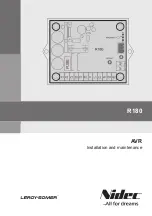Chapter 22 FlexCAN
MPC5602P Microcontroller Reference Manual, Rev. 4
534
Freescale Semiconductor
a vehicle, cost-effectiveness and required bandwidth. The FlexCAN module is a full implementation of the
CAN protocol specification, Version 2.0 B, which supports both standard and extended message frames.
32 Message Buffers are supported. The Message Buffers are stored in an embedded RAM dedicated to the
FlexCAN module.
The CAN Protocol Interface (CPI) submodule manages the serial communication on the CAN bus,
requesting RAM access for receiving and transmitting message frames, validating received messages and
performing error handling. The Message Buffer Management (MBM) submodule handles Message Buffer
selection for reception and transmission, taking care of arbitration and ID matching algorithms. The Bus
Interface Unit (BIU) submodule controls the access to and from the internal interface bus, in order to
establish connection to the CPU and to other blocks. Clocks, address and data buses, interrupt outputs and
test signals are accessed through the Bus Interface Unit.
One FlexCAN module is implemented on the MPC5602P device.
22.1.2
FlexCAN module features
The FlexCAN module includes these features:
•
Full Implementation of the CAN protocol specification, Version 2.0B
— Standard data and remote frames
— Extended data and remote frames
— 0 to 8 bytes data length
— Programmable bit rate as high as 1 Mbit/s
— Content-related addressing
•
32 Flexible Message Buffers (MBs) of 0 to 8 bytes data length
•
Each MB configurable as Rx or Tx, all supporting standard and extended messages
•
Individual Rx Mask Registers per Message Buffer
•
Includes 544 bytes (32 MBs) of RAM used for MB storage
•
Includes 128 bytes (32 MBs) of RAM used for individual Rx Mask Registers
•
Full-featured Rx FIFO with storage capacity for 6 frames and internal pointer handling
•
Powerful Rx FIFO ID filtering, capable of matching incoming IDs against either 8 extended, 16
standard, or 32 partial (8-bit) IDs, with individual masking capability
•
Selectable backwards compatibility with previous FlexCAN version
•
Programmable clock source to the CAN Protocol Interface, either bus clock or crystal oscillator
•
Unused MB and Rx Mask Register space can be used as general purpose RAM space
•
Listen-only mode capability
•
Programmable loop-back mode supporting self-test operation
•
Programmable transmission priority scheme: lowest ID, lowest buffer number or highest priority
•
Time Stamp based on 16-bit free-running timer
•
Global network time, synchronized by a specific message
•
Maskable interrupts


















